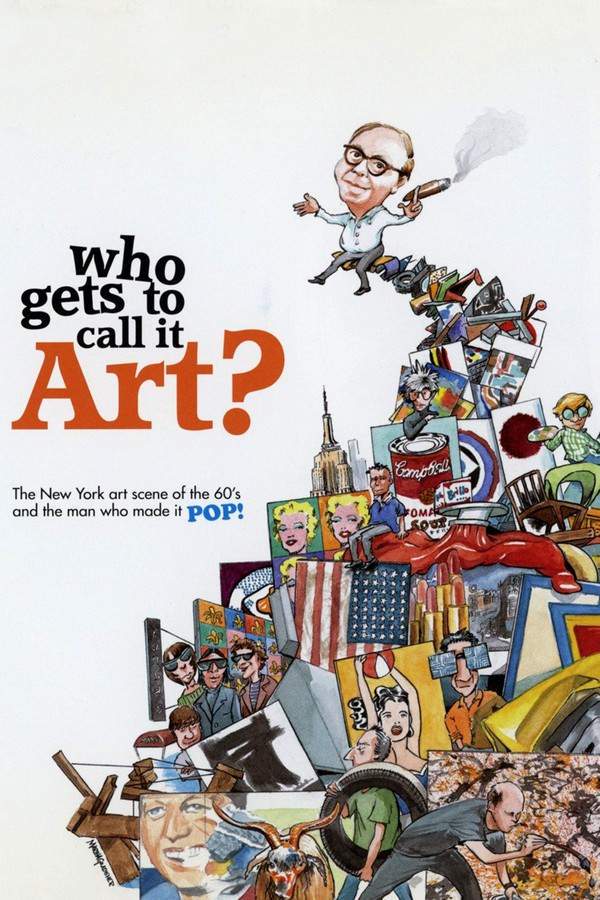
Who Gets to Call It Art? 2006
Directed by

Peter Rosen
Made by

Palm Pictures
Test your knowledge of Who Gets to Call It Art? with our quiz!
Who Gets to Call It Art? Plot Summary
Read the complete plot summary and ending explained for Who Gets to Call It Art? (2006). From turning points to emotional moments, uncover what really happened and why it matters.
A captivating journey through the vibrant 1960s downtown New York art scene unfolds, narrated by the iconic Metropolitan Museum of Art curator, Henry Geldzahler. The film kicks off with an engaging montage that encapsulates the essence of early 60s New York City. It highlights the explosion of creativity in advertising design and the beloved artists’ haven known as the Cedar Bar, a sanctuary for artists seeking refuge from the chill of the night. Figures like Jack Kerouac, Dennis Hopper, and Jackson Pollock are integrated into this rich tapestry, creating a dynamic community of creatives reminiscent of Paris in the early half of the century.
As Henry Geldzahler, a bright art historian freshly graduated from both Yale and Harvard, enters the New York art scene in the year of JFK’s election, the atmosphere is one of optimism and excitement. These were transformative times when artists, residing in affordable downtown lofts, began to liberate themselves from European influences and Abstract Expressionism, paving the way for something entirely new and authentically American.
The 60s became synonymous with experimentation and the questioning of norms, as the avant-garde thrived amidst openings, happenings, and parties, merging social life with the art world. Young, intelligent voices, from Beat poets to iconic figures like James Dean, emerged alongside innovative films, modern appliances, and cutting-edge product design in advertising. With low rents and a vibrant street lifestyle fostering creativity, anyone could dive into artistic pursuits, and Henry Geldzahler quickly established himself as a prominent figure in the downtown scene.
By 1970, having been the curator of contemporary art at The Metropolitan Museum of Art since 1962, Henry Geldzahler orchestrated an unprecedented exhibition titled New York Painting and Sculpture 1940-1970. This groundbreaking show, which spanned the museum’s 18th and 19th-century galleries, featured over 400 works by living American artists, including notable names like Chamberlain, Di Suvero, Flavin, Frankenthaler, Johns, Kelly, Kline, Noland, Oldenberg, Olitsky, Pollock, Poons, Rauschenberg, Rothko, Lichtenstein, Motherwell, Newman, Segal, Stella, and Warhol.
This centennial exhibition not only redefined the museum’s commitment to contemporary art but also attracted a new audience eager to engage with modern pieces. With his bold vision, Henry Geldzahler offered American art its much-deserved stamp of approval, affirming that it was not merely commendable, but profoundly significant and a wise investment for the future.
Who Gets to Call It Art? Timeline
Follow the complete movie timeline of Who Gets to Call It Art? (2006) with every major event in chronological order. Great for understanding complex plots and story progression.
Introduction to the 1960s Art Scene
The film opens with a vibrant montage that captures the essence of early 60s New York City. This lively portrayal showcases the creativity within advertising design and highlights the Cedar Bar, a sanctuary for artists.
Meeting Iconic Figures
As the narrative unfolds, notable figures such as Jack Kerouac, Dennis Hopper, and Jackson Pollock are introduced. These artists form a dynamic community reminiscent of earlier artistic gatherings in Paris.
Henry Geldzahler Enters the Scene
Henry Geldzahler, a recent graduate from Yale and Harvard, steps into the bustling New York art scene during the year of JFK's election. The atmosphere is optimistic, filled with excitement for new artistic expressions.
Liberation from European Influences
Artists begin to liberate themselves from European influences and Abstract Expressionism. This period marks the birth of new, authentically American art forms, as creative individuals explore various mediums and styles.
Rise of the Avant-Garde
The 1960s see a flourish of avant-garde art that thrives amidst openings and parties. The merging of social life with the art scene creates a fertile ground for experimentation and innovation.
Emergence of Young Voices
A wave of young, intelligent voices emerges in the art community, influenced by Beat poets and iconic figures like James Dean. These voices represent a new generation challenging artistic and societal norms.
Affordable Artistic Pursuits
With low rents in downtown New York, artists find a conducive environment to pursue their craft. This accessibility allows for an explosion of artistic expression and creativity among budding artists.
Geldzahler as Prominent Figure
Henry Geldzahler quickly establishes himself as a prominent figure in the downtown scene. His contributions to contemporary art with bold and innovative ideas help shape New York's artistic identity.
The Curatorship at The Met
By 1970, Henry Geldzahler has been the curator of contemporary art at The Metropolitan Museum of Art since 1962. His tenure marks a significant turn toward modern art in one of the world's most prestigious museums.
Groundbreaking Exhibition
In 1970, Geldzahler orchestrates the unprecedented exhibition titled 'New York Painting and Sculpture 1940-1970'. This display features over 400 works from prominent living American artists, redefining the museum's approach to contemporary art.
Attracting a New Audience
The centennial exhibition not only showcases modern art but attracts a new audience eager to engage with contemporary pieces. This shift represents a significant cultural transition within the museum.
Affirming American Art's Significance
Through his bold exhibitions, Henry Geldzahler affirms the significance of American art. He conveys its importance as a wise investment for the future, challenging preconceived notions of art's value and relevance.
Who Gets to Call It Art? Characters
Explore all characters from Who Gets to Call It Art? (2006). Get detailed profiles with their roles, arcs, and key relationships explained.
Henry Geldzahler
Henry Geldzahler was a prominent art historian and curator who played a crucial role in the 1960s New York art scene. Known for his bold vision and commitment to showcasing contemporary American art, he transformed public perceptions and appreciation for modern artists. Geldzahler's charisma and intellect established him as a significant figure among creatives during this vibrant time.
Who Gets to Call It Art? Settings
Learn where and when Who Gets to Call It Art? (2006) takes place. Explore the film’s settings, era, and how they shape the narrative.
Time period
1960s
The 1960s was a decade of significant cultural change, marked by experimentation and a questioning of societal norms. This era saw the emergence of avant-garde movements that reshaped the art landscape in America, separating it from European influences and celebrating authenticity. The election of JFK ignited a sense of optimism which permeated the art scene, encouraging new forms of expression.
Location
New York City, Cedar Bar
New York City in the 1960s was a vibrant hub of creativity and transformation. The Cedar Bar served as a beloved sanctuary for artists, providing a refuge where they could gather and share ideas. This setting fostered a unique dynamic community reminiscent of earlier artistic movements in Paris.
Who Gets to Call It Art? Themes
Discover the main themes in Who Gets to Call It Art? (2006). Analyze the deeper meanings, emotional layers, and social commentary behind the film.
🎨
Art Revolution
The film showcases the transformative power of art during the 1960s, highlighting the shift towards a uniquely American expression. Artists began breaking free from the constraints of previous styles, embracing innovation and experimentation as they created new narratives. This revolution not only redefined art but also changed societal perspectives about creative expression.
💡
Cultural Awakening
A cultural awakening during the 1960s fostered a community of young, intelligent voices and avant-garde thinkers. The film captures the intersection of various creative fields, including literature, art, and advertising, interweaving their influences on one another. This vibrant societal tapestry marked a significant moment in American history, pushing boundaries and inspiring future generations.

Coming soon on iOS and Android
The Plot Explained Mobile App
From blockbusters to hidden gems — dive into movie stories anytime, anywhere. Save your favorites, discover plots faster, and never miss a twist again.
Sign up to be the first to know when we launch. Your email stays private — always.
Who Gets to Call It Art? Spoiler-Free Summary
Discover the spoiler-free summary of Who Gets to Call It Art? (2006). Get a concise overview without any spoilers.
In the bustling heart of 1960s New York, a city humming with neon signs, jazz clubs, and restless creativity, a young art historian steps onto the scene with a vision that feels both rebellious and reverent. Henry Geldzahler arrives fresh from Ivy‑League classrooms, instantly drawn to the gritty lofts and smoky bars where painters, musicians, and writers blur the lines between discipline and daring. The documentary paints this era as a kinetic collage of street‑level energy and high‑brow ambition, inviting viewers to feel the pulse of a moment when America’s cultural identity was being rewritten on canvases, billboards, and the very walls of its museums.
Against this backdrop, Geldzahler emerges as a charismatic bridge between the avant‑garde underground and the venerable institutions of the art world. His enthusiasm for bold, unapologetically commercial aesthetics—think bright silkscreens and everyday objects elevated to fine art—creates a lively tension that fuels the film’s tone. Through archival footage, vivid interviews, and period music, the story captures his infectious optimism and fierce advocacy for artists who were still fighting for legitimacy, hinting at the transformative power of championing the new while honoring the past.
The film’s mood is simultaneously celebratory and reflective, a love letter to a decade that dared to question everything from tradition to taste. It invites curiosity about how one determined curator might sway public perception, inspire a generation of creators, and challenge the very definition of “art.” As the streets of Manhattan glow with possibility, the audience is left pondering the lasting echo of those daring choices, and how a single voice can help reshape a cultural landscape forever.
Can’t find your movie? Request a summary here.
Featured on this page

What's After the Movie?
Not sure whether to stay after the credits? Find out!
Explore Our Movie Platform
New Movie Releases (2025)
Famous Movie Actors
Top Film Production Studios
Movie Plot Summaries & Endings
Major Movie Awards & Winners
Best Concert Films & Music Documentaries
Movie Collections and Curated Lists
© 2025 What's After the Movie. All rights reserved.





